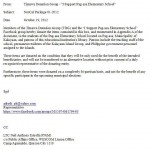
Philippine Defense Today (Adroth.ph)
In Defense of the Republic of the PhilippinesWhat is a #pagasaKIG node?
Leave a commentA node consists of three basic elements:
- Funder – provides the financial capability to acquire donation items or pay for services
- Buyer – acquires items and/or services at the best possible price, and with full documentation (e.g., responsible for acknowledging receipt of funds, publishing copies of receipts, etc.
- Shipper – responsible for receiving items and sending them to the designated recipient. Futhermore, the shipper is responsible for writing the deed of donation.
A sample of the deed that the group used for the pilot project appears below. This template is simply a guide for the intent of the deed.
 |
Nodes, particularly those that include members of the bar, are free to draft their own deeds and are actually encouraged to share copies of those amended deeds to the community so that everyone can benefit from their experience. However, the following key facets of the deed are a minimum requirement to be recognized as a being within the #pagasaKIG framework:
1. Donors should not demand personal recognition as a pre-condition of the donation
2. Donations will be free of vested, personal, interests and will remain in the spirit of the original pilot donation
Any time those three elements come together and form a circle of trust — a node is created. Here are some examples of how different nodes operated during the pilot phase of the project.
One-stop-shop
The Northern California node started with one individual that was responsible for funding, buying, and shipping his own donation items. As word of the project spread, other donors in the vicinity decided to ship their items along with the founding node member’s items thus avoiding redundant shipping costs.
The NorCal node operated as a multi-funder, multi-buyer, single-shipper node
Fund-the-buyer
The leader of the NCR node is a frequent visitor of shops in Divisoria and is intimately aware of the ins and outs of that shopping complex. During the pilot project, a canvass of school supplies in Divisoria and in other areas — to include Puerto Princessa — showed that funds would go further if bought in the capital.
So donors in the NCR, Bicol, and even as far as Colorado, sent their funds to the NCR node which then took responsibility for purchasing the school supplies
The NCR node operated as a multi-funder, single-buyer, single-shipper node
Tapping local expertise
The Singapore node followed a similar model as the NCR node, however the local contact was chosen for expertise in reference material selection. Funds from Singapore were sent to an educator in Quezon City who then acquired various books and educational tools from vendors that teachers frequented.